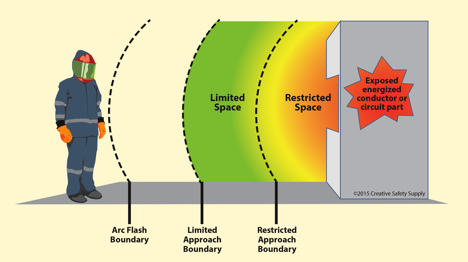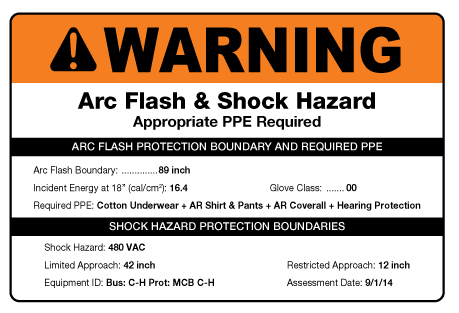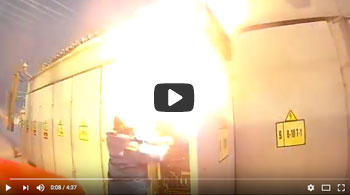Multiple reports and surveys estimate the average number of arc flash incidents every year, the sum totaled around 30,000 arc flash incidents. This means that a percentage of arc flash victims suffer from serious burn injuries and end up in life-threatening positions resulting in long-term hospitalization.
It’s important to know the dangers of arc flash and the causes behind such a life-threatening occurrence. In this article, we’ll explain everything you need to know about arc flash prevention.
What Is Arc Flash?
Electrical arcing begins when the electricity exits its intended path and begins traveling through the air toward a grounded area. Once this happens, it ionizes the air, which further reduces the overall resistance along the path that the arc is taking. This helps draw in additional electrical energy.
The electric arc will travel toward a ground of some type, which will typically be whatever object is closest to its source. The exact distance that an arc flash can travel is known as the arc flash boundary. This is determined by the potential energy present and a variety of other factors such as air temperature and humidity.
In simple terms, an Arc flash is the release of energy that occurs when there is an electrical fault. When a live wire meets a grounding or earthed wire, it will result in a massive explosion of electricity. An arch flash is the sudden release or explosion of energy due to malfunctioning equipment or a short circuit. The pressure produced due to the wave of electricity traveling its unintended path can produce an excessive amount of heat which can incur second or third-degree burns to unsusceptible individuals or workers nearby. That’s why its important to be aware of the causes of arc flashes and take the right precautions to avoid the worst-case scenario.
How Long Does an Arc Flash Last?
An arc flash can last anywhere from a fraction of a second to several seconds, depending on a number of factors. Most arc flashes don't last very long because the source of the electricity is cut off quickly by circuit breakers or other safety equipment. The most advanced systems today use devices known as arc eliminators, which detect and extinguish the arc within just a few milliseconds.
What Causes an Arc Flash?
The reason behind the cause of an arch flash is the unintentional contact an electrically charged conductor or a live wire, with another earthed surface, a grounded wire. In simple terms, when wires wear down under constant strain, the insulation might melt exposing the wire and increasing the possibility of an arch flash. An arc flash may occur due to loose connections as well.
Contrary to popular belief, the risk of an arch flash occurs only under high-voltage equipment failure however, that is not entirely true. Certain case studies suggest that low-voltage arc flash incidents may be even riskier.
In most cases, the root cause of an arc flash will be a damaged piece of equipment such as a wire. It could also be a result of someone working on equipment, which makes it possible for the electricity to escape from the path it is normally confined to.
Electricity is always going to follow the path of least resistance. This is why an arc flash will not necessarily happen as soon as something is damaged, or an alternate path is made available. Instead, the electricity will continue down the intended path until another option that has less resistance becomes available.
The following are some examples that can create a path with lower resistance, and therefore cause an arc flash:
- Dust - In dusty areas the electricity may begin passing outside the wiring or other equipment through dust.
- Dropped Tools - If a tool is dropped onto a wire, for example, it can damage it and allow the electricity to pass into the tool. From there, it must find another path to continue on.
- Accidental Touching - If a person touches the damaged area, the electricity may travel through his or her body, or at least out of the normal path.
- Condensation - When condensation forms, electricity may escape the wiring through the water.
- Material Failure - If a wire is damaged to the point where the electricity has trouble passing through, the path may be more resistant than going outside of the wire.
- Corrosion - Corrosion can create a path outside the wire.
- Faulty Installation - When equipment is installed improperly it can make it difficult or impossible for electricity to follow the intended path.
In the event of an arc flash, the temperature of the heat produced can reach up to 35,000 °F, which is three times hotter than the sun. This explosive temperature can cause the air and metal in the intended path to expand resulting in an explosion, therefore creating an arc blast.

Arc Flash VS Arc Blast
When an electrical conductor or wire meets with an earthed conductor or grounded wire, it results in the accumulation of excessive heat. This heat creates the opportunity of an arc flash causing a visibly blinding flash to occur. When the flash happens, it causes the surrounding air and metal to expand causing an arc blast. So, the pressure wave in the air that follows after an arc flash is the arc blast.
The dangers of electrical hazards are numerous, that’s why it’s important to implement the necessary arc flash preventative measures to ensure your safety.
Preventing an Arc Flash
The first step in arc flash prevention is minimizing the risk of one occurring. This can be done by completing an electrical risk assessment, which can help identify where the biggest dangers are in a facility.
Routine inspections of all high-voltage equipment such as electrical switchboards, panelboards, control panels, socket enclosures, motor control centers, and all wiring are essential. If there is any sign of corrosion, damage to wires, or other issues, they should be fixed as soon as possible. This will help keep the electrical currents safely contained within the machines and wires where they belong.

Proper Labeling Efforts
Anywhere in a facility where high electrical currents can exist should be properly labeled with arc flash warning labels. These can be purchased pre-made or printed with any industrial label printer as they are needed. The National Electrical Code article 110.16 clearly states that this type of equipment needs to be marked to warn workers of the risks.
De-Energizing Equipment when Performing Maintenance
Whenever a machine needs to be worked on in any way, it should be completely de-energized. De-energizing a machine is more than just turning it off. All machines should be shut down and physically disconnected from any power source. Once disconnected, a voltage check should also be done to ensure there is no latent energy stored away.
Ideally, a lockout/tagout policy should be in place, which will put a physical lock on the electrical supply so that it cannot be accidentally plugged back in while someone is working on it.
Arc Flash Personal Protection Equipment (PPE)
It should be very rare, but there are some cases when machines must be worked on while they are still energized. When this is the case, all employees working in the area should be required to wear proper personal protective equipment such as safety goggles, hearing protection, voltage-rated gloves, and arc-rated clothing.
The specific PPE that is worn should correspond to the maximum potential risk based on the amount of electricity going through the machine. Having head-to-toe personal protective equipment can help to prevent serious arc flash incidents or even fatality should an arc flash occur while the machine is being worked on.
Circuit Breakers
Whenever possible, circuit breakers should be put in place on all machines. These breakers will quickly detect when there is a sudden power surge in electricity being drawn and stop the flow immediately. When there is excessive accumulation of heat which is the ultimate cause of an arc flash, circuit breakers can eliminate the possibility of an arc flash. Even with circuit breakers, an arc flash can occur, but it will only last a fraction of the time since the electrical current will be cut off. However, the severity of just a very brief arc flash can be deadly. For this reason, circuit breakers should not be seen as a sufficient arc flash safety program.
Potential Damages of an Arc Flash
Due to high temperatures of up to 35,000°F, intense blasts, and other results of an arc flash, these electrical mishaps can cause a lot of damage very quickly. Understanding the different types of damage that can occur can help facilities plan their safety efforts. The following are all examples of what an arc flash or arc blast are capable of.
Potential Property Damage:
- Heat - The heat from an arc flash can easily melt metal, which can damage expensive machines and other equipment.
- Fire - The heat from these flashes can quickly cause a fire, which can spread through a facility if not stopped.
- Blasts - Arc blasts can break windows, splinter wood in the area, and even bend metal. Anything stored within the arc blast radius can be damaged or destroyed in just seconds.
Potential Human Injury:
- Burns - Second and third-degree burns can occur in a fraction of a second.
- Electrocution - Depending on the amount of electricity, where it enters the body, and where it leaves, electrocution can be fatal.
- Auditory Damage - Arc flashes are capable of producing extremely loud noises, which can cause permanent hearing damage.
- Eyesight Damage - Arc flashes can be very bright, which can cause temporary or even long-term damage to the eyes.
- Arc Blast Damage - An arc blast can create a force that is thousands of pounds per inch. This can knock a person back several feet. It can also cause broken bones, collapsed lungs, and concussions.
Wearing personal protective equipment can provide a significant amount of arc fault protection, but it cannot eliminate all risk. Workers who are present when an arc flash occurs are always at risk, no matter the PPE they are wearing. This is why it is important to de-energize a machine before it is worked on whenever possible.
Similar Articles
- Arc Flash and Electrical Safety
- Arc Flash Software helps improve Arc Flash Safety
- Arc Flash PPE
- Arc Flash Labeling (Updated)
- Arc Flash Label Requirements [2018 Updates]
- Electric Arc [Definition, Applications & Arc Flash]
- 10 Essential Steps for Electrical Safety
- Electrical Wire Colors
- Electrical Wiring (Wire Color Codes)
- NFPA 70E [Workplace Electrical Safety]




